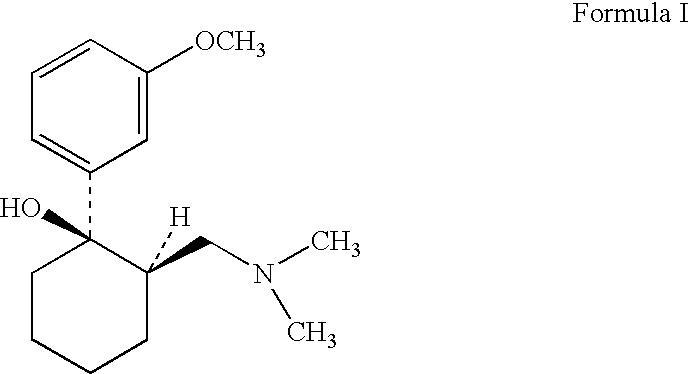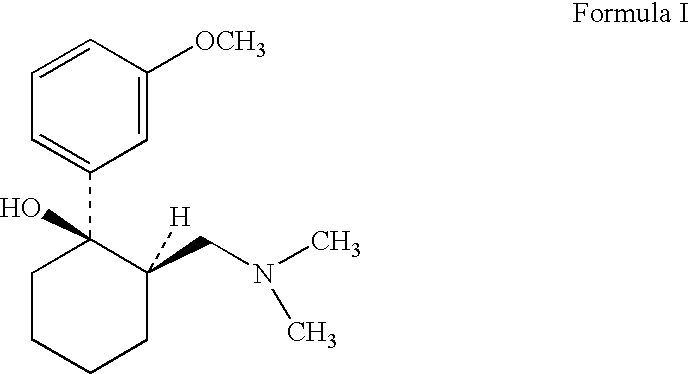Tramadol recovery process
a technology of tramadol and recovery process, which is applied in the direction of diaryl/triaryl methane dye, organic racemization, biocide, etc., can solve the problems of inability to recover, and inability to meet the requirements of repeated crystallization
- Summary
- Abstract
- Description
- Claims
- Application Information
AI Technical Summary
Benefits of technology
Problems solved by technology
Method used
Image
Examples
example
Example 1
Tramadol benzoate
[0043]In a reaction flask 24.1 g tramadol base (of cis / trans ratio about 83:17) was mixed with 100 ml methylene chloride. 11.50 gm of benzoic acid was added into the mixture and stirred for about 2 hours. The solvent was then removed by evaporation under reduced pressure. The residue obtained was mixed with 110 ml methanol and water in ratio of 95:5. The mass was heated to reflux for 1 hour and cooled to room temperature and maintained for additional 1 hour. Further the mass was chilled to 10° C., precipitated salt was filtered, washed with methanol and dried under vacuum to obtain 22.4 gm (63%) cis-2-[(dimethylamino) methyl]-1-(3-methoxyphenyl)cyclohexanol benzoate salt (cis =99.62% & trans =0.38%).
example 2
Tramadol salicylate
[0044]In a reaction flask 65.25 g tramadol base (of cis / trans ratio about 83:17) was mixed with 100 ml methylene chloride. 34.26 gm of salicylic acid was added into the mixture and stirred for about 2 hours. The solvent was then removed by evaporation under reduced pressure. The residue obtained was mixed with 115 ml methanol: water in ratio of 95:5. The mass was heated to reflux for 1 hour and cooled to room temperature and maintained for additional 1 hour. Further the mass was chilled to 10° C., precipitated salt was filtered, washed with methanol and dried under vacuum to obtain 70.95 gm (71%) cis-2-[(dimethylamino) methyl]-1-(3-methoxyphenyl)-1-cyclohexanol salicylate salt (cis =99.1 & trans =0.88).
example 3
Tramadol salicylate
[0045]In a reaction flask 168.3 g tramadol base (of cis / trans ratio about 83:17) was mixed with 547.2 ml methanol-water mixture 487.5 ml (methanol:water ratio—3:0.23 v / v) and 86.59 gm of salicylic acid was added and stirred for about 30 minutes. The mass was heated to reflux for 30 minutes and cooled to room temperature & maintained for further 30 minutes. The mass was then chilled to 5 degrees, the precipitated salt was filtered, washed with chilled methanol and dried under vacuum to obtain 158.52 gm (69.32%) cis-2- [(dimethylamino) methyl]-1-(3-methoxyphenyl)-1-cyclohexanol salicylate salt (cis=99.98 & trans=0.02 by HPLC area %).
PUM
| Property | Measurement | Unit |
|---|---|---|
| temperature | aaaaa | aaaaa |
| temperature | aaaaa | aaaaa |
| temperature | aaaaa | aaaaa |
Abstract
Description
Claims
Application Information
 Login to View More
Login to View More - R&D
- Intellectual Property
- Life Sciences
- Materials
- Tech Scout
- Unparalleled Data Quality
- Higher Quality Content
- 60% Fewer Hallucinations
Browse by: Latest US Patents, China's latest patents, Technical Efficacy Thesaurus, Application Domain, Technology Topic, Popular Technical Reports.
© 2025 PatSnap. All rights reserved.Legal|Privacy policy|Modern Slavery Act Transparency Statement|Sitemap|About US| Contact US: help@patsnap.com



